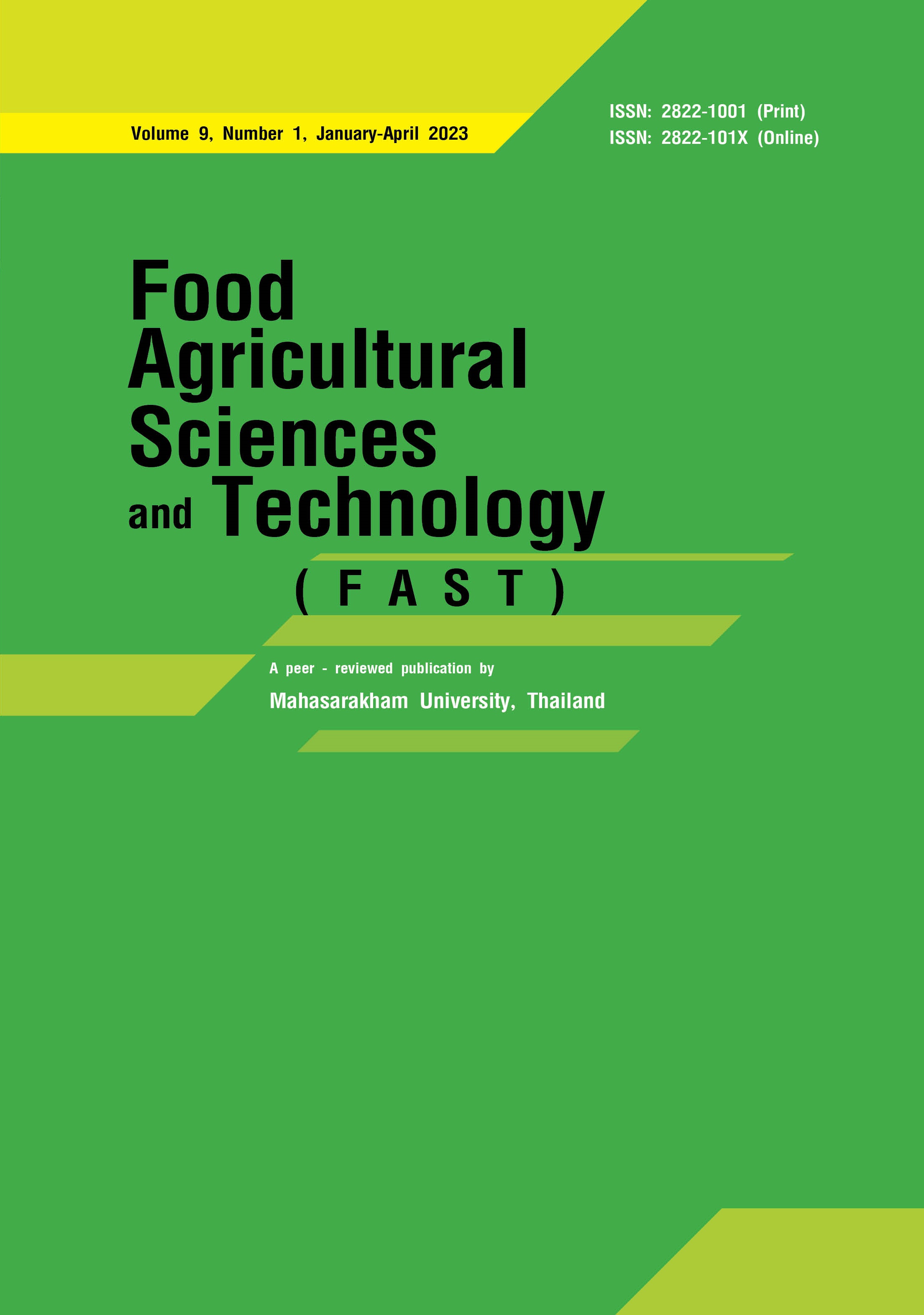Intimate stories told by the grain proteins of Australian wheat and Thai rice .... to the police, to breeders, to grain growers, to grain handlers, to processors and to us as consumers
Keywords:
Variety identification, quality attribute, genome, capillarye electrophoresisAbstract
All cereal grains have genetic (“intimate”) information “locked up” in the grain proteins. Accessing this information requires suitable methods of protein extraction and fractionation. Here we describe how this research approach can reveal information about stolen wheat - reliable evidence to be accepted in court. Plant breeders also rely on the grain-protein “semantides” to predict the type of grain quality (even from just a single grain), thus to produce new varieties of suitable quality. That same semantic information can subsequently be used after harvest to ensure that grain deliveries of the appropriate quality type are binned together, but separate from grain of different quality. Information about the grain proteins is also critical to the processing and consumption of grain-based foods.
References
Appleyard, D.B., McCausland, J., and Wrigley, C.W. (1979). Checking the identity and origin of off-types in the propagation of pedigreed wheat seed. Seed Sci. Technol, 7, 459-466.
Bekes, F., & Wrigley, C.W. (2013). Gluten alleles and predicted dough-quality for wheats world-wide: A great resource, free on the AACCI web site. Cereal Foods World, 58(6), 325-328.
Bekes, F., Schoenlechner, R., and Tomoslozi, S. (2017). Ancient wheats and pseudocereals for possible use in cereal-grain intolerances. In C. Wrigley & I. Batey (eds), Cereal Grains: Assessing and Managing Quality (pp. 353-389). Woodhead Publishing, Cambridge.
Lookhart, G.L. & Wrigley, C.W. (1995). Electrophoretic analysis. In C. Wrigley (Ed.), Identification of food-grain varieties (pp. 55-71). Amer. Assoc. Cereal Chem
Metakovsky, E.V., Wrigley, C.W., Bekes, F. & Gupta, R.B. (1990). Gluten polypeptides as useful genetic markers of dough quality in Australian wheats. Aust. J. Agric. Res, 41, 289-306.
Metakovsky, E.V., Melnik, V.A., Pascual, L., & Wrigley, C.W.(2019a). Gliadin alleles worldwide for spring wheats (Triticum aestivum L.). 1. Genetic diversity and grain-quality gliadin alleles during the 20th century. J. Cereal Sci, 87, 172-177.
Metakovsky, E.V., Melnik, V.A., Pascual, L., & Wrigley, C.W. (2019b). Gliadin alleles worldwide for spring wheats (Triticum aestivum L.). 2. Strong differentiation of polymorphism between countries and regions of origin. J. Cereal Sci, 87, 311-317.
Metakovsky, E.V., Melnik, V.A., Pascual, L., Romanov, G.A., & Wrigley, C.W. (2019c). Types, frequencies and value of intra-varietal genotypic non-uniformity in common wheat cultivars: Authentic biotypes and foreign seeds. J. Cereal Sci, 89, 102813.
Metakovsky, E., Melnik, V.A., Pascual, L. & Wrigley, C.W. (2020). Over 40% of 450 registered wheat cultivars (Triticum aestivum) worldwide are composed of multiple biotypes. Journal of Cereal Science, 96, 103088.
Metakovsky, E.; Pascual, L.; Vaccino, P.; Melnik, V.; Rodriguez-Quijano, M.; Popovych, Y.; Chebotar, S.; Rogers, W.J. Heteroalleles in Common Wheat: Multiple Differences between Allelic Variants of the Gli-B1 Locus. Int. J. Mol. Sci., 22, 1832.
Ross, A., Walker, C.E., Booth, R.I., Orth, R.A. & Wrigley, C.W. (1987). The Rapid Visco-Analyzer: a new technique for the estimation of sprout damage. Cereal Foods World, 32, 827-829.
Rustgi, S., Kashyap, S., Deleu, L.J., & Delcour, J.A. (2021). Reduced immunogenicity wheat now coming to age. in S. H. Wani et al. (eds.), ‘Physiological, molecular, and genetic perspectives of wheat improvement’ (pp. 15-42) https:// doi.org/10.1007/978-3-030-59577- 7_2.
Siriamornpun, S., Wootton, M., Cox, J.M., Bekes, F., & Wrigley, C.W. (2001). Capillary electrophoresis of wheat gliadin proteins and its potential for wheat varietal identification using pattern-matching software. Aust. J. Agric. Research, 52, 839- 843.
Siriamornpun, S., Suttajit, M., Uthayakumaran, S, & Wrigley, C.W. (2004a). Identification of Thai rice varieties using capillary electrophoresis. In C.K.Black, J.F. Panozzo & G.J. Rebetzke (Eds), Cereals 2004. Proc. 54th Aust. Cereal Chem. Conf. and the 11th Wheat Breeders’ Assembly (pp. 181-184). Royal Aust. Chem. Inst.
Siriamornpun, S., Suttajit, M., & Wrigley, C.W. (2004b). Rice variety identification by capillary electrophoresis and SDS-PAGE. In C.K.Black, J.F. Panozzo & G.J. Rebetzke (Eds), Cereals 2004. Proc. 54th Aust. Cereal Chem. Conf. and the 11th Wheat Breeders’ Assembly (pp. 185-187). Royal Aust. Chem. Inst.
Siriamornpun,S., Suttajit, M., Uthayakumaran, S., & Wrigley, C.W. (2005). Protein analysis for efficient screening of rice for variety and quality. Food Sci. Aust. 57, 448-450.
Tran-Dinh, N., Uthayakumaran, S., Batey, I.L., & Wrigley, C.W. (2009). Rapid DNA-based identification of wheat and barley varieties. J. Cereal Sci, 50, 388-391.
Uthayakumaran, S., Batey, I.L., and Wrigley, C.W. (2005). On-the-spot identification of grain variety and wheat-quality type by Lab-ona-chip capillary electrophoresis. J. Cereal Sci, 41, 371-374.
Wrigley, C.W. (2016). The grain chain: The route from genes through to grain- based products. In C. Wrigley, H. Corke, K. Seetharaman, & J. Faubion (Eds.), Encyclopedia of food grains (2nd edition) (pp. 22- 30). Elsevier Ltd.
Wrigley, C.W. & Gooding, M.J. (2009a). Wheat in the grain chain: Managing production to optimize grain quality. Cereal Foods World, 54, 58-63.
Wrigley, C.W., Asenstorfer, R., Batey, I.L., Cornish, G.B., Day, L., Mares, D., & Mrva, K. (2009b). The biochemical and molecular basis of wheat quality. Chapter 21. In B. Carver (Ed), ‘Wheat: Science and Trade’. Wiley-Blackwell.
Wrigley, C.W., Autran, J.C. & Bushuk, W. (1982). Identification of cereal varieties by gel electrophoresis of the grain proteins. Advances in Cereal Science and Technology, 5, 211-259.
Downloads
Published
How to Cite
Issue
Section
License
Copyright (c) 2023 Food Agricultural Sciences and Technology (FAST)

This work is licensed under a Creative Commons Attribution-NoDerivatives 4.0 International License.







